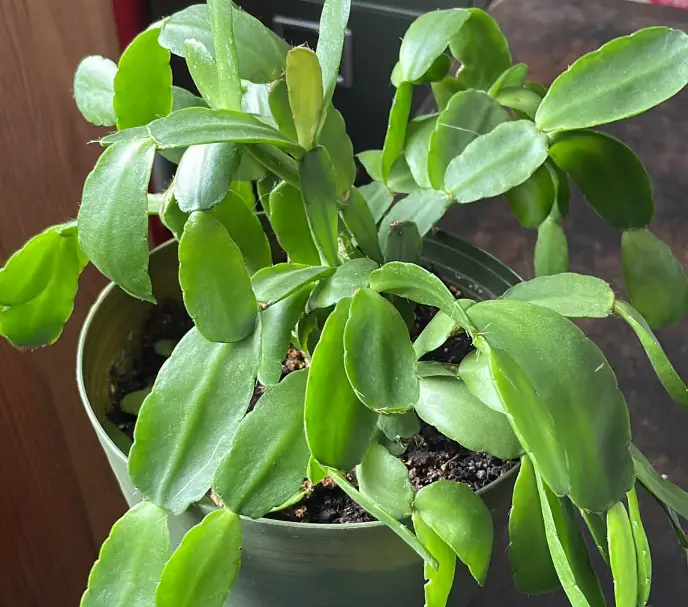Signs of Underwatered Christmas Cactus and What to Do
Christmas cacti are native to Brazil’s humid, tropical forests, where they grow as epiphytes on rocks and tree branches. They are adapted to frequent rainfall and high humidity levels, and as houseplants, they will need regular watering to maintain healthy growth.
Water is important for the growth and development of plant tissues, including buds and flower production. Underwatering a Christmas cactus can lead to stunted growth, flower buds falling off, and even death of the plant.
If your Christmas cactus is severely dehydrated and the leaves have wilted or shriveled, you can try to revive it by submerging the pot in a bucket of water for about an hour. This will allow the soil to absorb water from the bottom up and rehydrate the roots.
If the bottom watering is not reaching the top, the soil might be too dry. Mist the plant with a spray bottle for several days until it recovers. If there is no improvement, it’s likely the plant has died.

Signs of Underwatered Christmas cactus
It can be difficult to tell if your cactus is underwatered as signs usually appear similar to other problems, including overwatering.
According to New Mexico State University, many factors can lead to a Christmas cactus shriveling, and you must determine the most likely cause of the problem under your growing conditions.
If you haven’t watered your Christmas cactus in a while, it will start showing the following symptoms:
1. Discoloration
Discoloration is a common sign of distress in cacti plants. It is usually linked to damaged roots in underwatered and overwatered Christmas cactus plants. Root cells usually die when they don’t receive air or water.
Underwatered Christmas cacti may turn yellow and slowly brown as they wilt.
2. Cactus shriveling
Thirsty Christmas cactus will shrink and become droopy. Plant cells usually lose turgidity when dehydrated; you can notice this from the curling leaves. In some cases, shriveling acts as a mechanism to reduce water loss.
With prolonged dehydration, a shriveled Christmas cactus will eventually wilt and die.
3. Stunted growth
Water is essential in photosynthesis; without it, a plant cannot produce sufficient sugars for its growth. Water and fertilizer needs of a Christmas cactus fertilizer increase when the plant enters active growth in spring and summer.
4. Brittle roots
The best way to tell if your Christmas cactus is underwatered or overwatered is by checking its roots. Without enough moisture, the cactus roots usually get dry and brittle, and they can even break into pieces when you pull them.
On the other hand, Christmas cactus roots get dark and mushy when the plant is overwatered, signifying root rot.
Overwatered vs. underwatered Christmas cactus
Sometimes underwatered and overwatered Christmas cacti display similar symptoms. Here is a summary of the differences between the two watering conditions.
| Overwatered Christmas cactus | Underwatered Christmas cactus |
| An overwatered plant dies within a short period of time. | The affected plant takes longer before it dies. |
| It’s not easy to save an overwatered Christmas cactus. | It is easy to save an underwatered Christmas cactus. |
| The roots of the affected plant become mushy or rotten. | The roots become dry and brittle. |
| The soil feels soggy to the touch. | The soil feels dry to the touch. |
| The whole plant may turn black and mushy as a result of rotting. | The whole plant may turn brown and dry up. |
| The plant may fall over when the roots get mushy and rotten. | The plant remains upright and supported by brittle roots. |
| There will be a bad smell from the soil as the plant parts decompose. | There is no likelihood of a bad smell around the plant. |
How to revive underwatered Christmas cactus
Underwatered Christmas cacti can only be revived through watering. However, do not blast the plant with water in this state. The roots are very weak, and watering them too much may cause them to drown.
On the first day, mist the plant leaves and the soil with room-temperature water using a spray bottle. Ensure the watering is so moderate that no water comes through the pot’s drainage holes. Repeat the same process every other day for two weeks.
Once the plant has recovered from dehydration symptoms, water it from below. Fill a large container with water approximately 2 inches and let your cactus planter sit in it for about one hour.
Once the top of the soil gets moist, let the soil drain for about 15 minutes and empty the saucer underneath the pot. This will help prevent Christmas cactus root rot.
After that, adjust your watering schedule to keep the soil consistently moist but not waterlogged. Water your Christmas cactus when the top inch of the soil feels dry to the touch. You can also mist the plant when the air is dry to help increase humidity around the leaves.
Note: Christmas cactus needs less watering during fall and winter. You’ll also have to keep the plant in uninterrupted darkness for 12 to 14 hours for six to eight weeks to encourage blooming.
Final Thought
To ensure the health and growth of your cactus, it’s important to water it regularly based on the size of the plant, the humidity levels, and the temperature. Water only when the top inch of the soil is dry. Overwatering is equally harmful to cacti as it causes root rot.
References:
- “THANKSGIVING & CHRISTMAS CACTI,” Clemson Cooperative Extension
- “Holiday cacti,” the University of Minnesota Extension
- “Christmas Cactus,” Texas AgriLife Extension Service
My name is Diane M Lewik, and I am the founder of this website. I am a degree holder in plant biology from the University of California – Berkeley. Over years, I have cultivated a vast collection of succulents and I have learned a great deal about how to grow and care for these unique plants.





